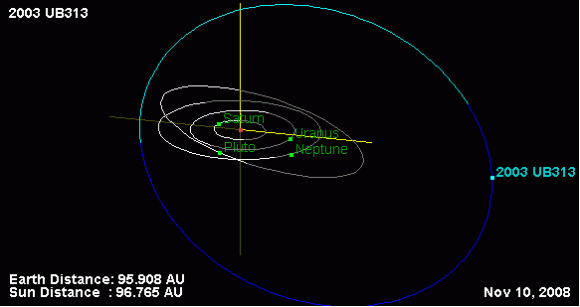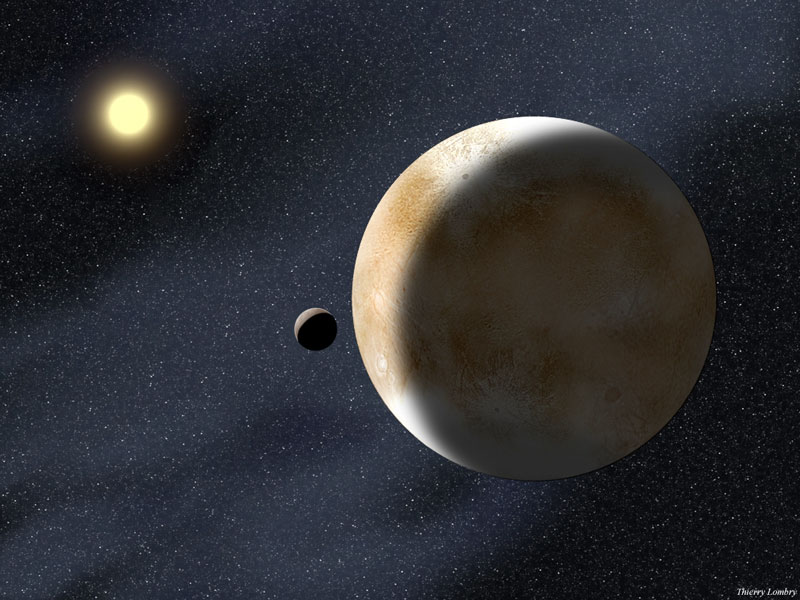[/caption]Eris, the largest dwarf planet beyond Neptune, is currently at its furthest point in its orbit from the Sun (an aphelion of nearly 100 AU). At this distance Eris doesn’t receive very much sunlight and any heating of the Plutoid will be at a minimum. However, two recent observations of Eris have shown a rapid change in the surface composition of the body. Spectroscopic analysis suggests the concentration of frozen nitrogen has dramatically altered during the two years Eris had been at this furthest point from the Sun. This is very unexpected, there should be very little change in nitrogen concentration at this point in its 557 year orbit.
So what is going on with this strange Plutoid? Is there a mystery mechanism affecting the surface conditions of this frozen moon? Could there be some cryovolcanic process erupting? Or is the explanation a little more mundane?
“We’re really scratching our heads,” says Stephen Tegler of Northern Arizona University in Flagstaff, author of the new Eris research (to be published in the journal Icarus). Tegler and his team analysed spectroscopic data from the 6.5 metre MMT observatory in Arizona and compared their 2007 results with a similar observation campaign by the 4.2 metre William Herschel Telescope in Spain two years earlier in 2005.
During that two year period, the scientists wouldn’t have thought there would be much difference in the two datasets. After all, the reflected sunlight off the surface of Eris should reveal a similar surface composition, right? Actually, the results couldn’t be more surprising. It would appear that within two years, having not changed its distance from the Sun significantly, the surface composition has changed a lot. Normally, this would be expected if a planetary body approaches or travels away from the Sun; the increase or decrease in solar energy would change the weather conditions on the surface. But this situation does not apply to Eris, there is little chance that the Sun could influence the weather on the surface of Eris to any degree (or, indeed, if Eris even has “weather”).

So what have the researchers deduced from the comparison of the 2005/2007 data? It would appear the spectroscopic methane lines have become diluted by an increased quantity of nitrogen. This means that the 2005 results showed a higher concentration of nitrogen near the surface, whereas the 2007 results show a higher concentration below the surface. For a dwarf planet to demonstrate a very fast change in surface composition appears to show some very dynamic process is at work.
So what could have caused this change? In the case of a dynamic weather process, “it’s very hard to imagine that something that dramatic would be happening on a relatively short time scale,” says Mike Brown of Caltech, a scientist not involved with the research. Another possibility is that 2003ub313 is a cryovolcanic body. Cryovolcanoes can erupt on icy moons or bodies in the Kuiper belt, but rather than spewing molten rock (magma), they erupt volatiles like ammonia, water or (in this case) nitrogen and methane. The ejected cryomagma then condenses into a solid, thus changing the surface composition of the icy body.
But it is not known whether Eris is warm enough for such a process to work. More information on trans-Neptunian object (TNO) cryovolcanism will be examined when NASA’s New Horizons mission reaches Eris’ smaller cousin Pluto in 2015. “If a shrimpy little body like Pluto can do it, Eris can too,” said co-author William Grundy of Lowell Observatory in Flagstaff, Arizona.
However, there is a possibility that the surface composition of Eris hasn’t changed at all. The 2005 and 2007 observations may have been analysing two different regions on the dwarf planet, thus the difference in surface composition (after all, the Plutoid has a rotation period of 26 hours, they would have almost definitely have seen different parts of Eris). So the next step for the researchers is to carry out an extended campaign throughout an “Eris day” to see if the surface composition is in fact patchy, which would be an interesting discovery in itself.
Publication: arXiv:0811.0825v1 [astro-ph]
Original source: New Scientist


Mike, you are right on the money. When I was working as a solar physics researcher I attended a memorable conference. There was a healthy mix of practical guys and us theorists there. However, one of the keynote speakers (a well-known solar astronomer) was keen to point out that so much more physics could be done if the theorists would “get real” and understand what the solar physics community needed.
His point was that rather than ploughing so much money into advanced optics to produce “media friendly” pictures, more work should be done in directing funds into advanced spectrometers. The depth of science that can be done will be far greater than just seeing small-scale “2D” features.
At the time I didn’t understand his point and disregarded it, after all I thought more physics could be done by analysing a picture (who needs advanced spectrometers for a star — the Sun — that is on our doorstep?).
Only now am I understanding the power of spectroscopy, now I’m reading research about uncovering the surface composition of a minor planet 100 AU away, or digging deep into a star-forming region of a galaxy millions of light years distant.
I’ve recently blown the dust off my spectroscopy books with a renewed interest in the field 🙂
I am in awe of this research, although solar physics was fun, I sometimes think probing disant planets would be more exciting!
Cheers, Ian
Very cool report. I’d like to hear the resutls of their experament.
I hate to sound so amateurish, but I am constantly amazed at the ability and value of spectroscopic reasearchers. To reach out that far to a small piece of non heat producing matter and discern atmospheric changes is just mind boggling.
Reaching out billions of light years to read chemistry and red shifts is amazing as well, but somehow a cold object like our “neighbor” seems more of a challenge. At any rate, spectroscopic research should receive a healthy amount of funding.
A line from the head of the University of Leicester Dept of Physics and Astronomy.
“A picture is worth a thousand words but a spectrum is worth a thousand pictures.”
Not that I want to wish my life away, but its moments like these that make me wish New Horizons wasn’t 7 years from Pluto.
Thanks for the insight. I’ll have to modify my website on the Eris.
Good point. Any chance that New Horizons could go on to Eris after the Pluto/Charon flyby in 2015? From what I’ve read earlier, it sounded like they’d have one more shot at some distant body.
Come on guys. The answer is obvious. Little green guys from Aldeberan are mining the nitrogen.
😛
This is more a reply to the comment than to the article itself (which is great, apart from calling “moon” to the poor planet Eris 😉 ), but I fully agree that from a purely scientific point of vue spectroscopy is way more valuable than photography. However, we wouldn’t have anywhere near as much public interest and support for these studies without the pictures, and that, as we know, ultimately translates into more students, more money and better instruments.
And besides, the two things complement eachother. We may find spectroscopically these changes in Eris and scratch our heads as to what causes them, but if we had a camera there and saw volcanic structures, we’d be a whole lot closer to actually knowing.
Hmmm. The nitrogen moved suddenly from below the surface to above. Maybe a chunk of rock/ice out there smashed into it???
Could cyrovolcanism on a large enough scale alter a bodies orbit? Has that mechanism, or outspewing of gasses ever been attributed to modifying the orbit of comets from the kupier belt to start spinning or head in to the inner solar system?
There is no such thing as non-heat producing matter. It just depends on what wavelength of the spectrum you are looking at. The Infrared signature of cold planets are very weak but still enough to be measured by high resolution spectroscopic analysis.
James said:
Maybe a chunk of rock/ice out there smashed into it???
YES! It was hit by a comet.
The better possibilirty is that two different hemispheres of Xena were observed. It could be a lot like Iapetus.
Edu:
“There is no such thing as non-heat producing matter.”
Thanks. And I am aware that movement, including at the atomic level, IS heat. I was just trying to distinguish fusion level heat from cold distant (from the sun) type heat.
Regarding the comment about NH being redirected towards Eris, post Pluto-flyby. Assuming the orbit diagram for 2003UB313 represents the current positions of solar system bodies then NH investigations of any KBO’s are restricted to a fairly small cone of trajectories beyond Pluto; and way too small to consider Eris as a target.
Taking 9 years to reach ~30AU at Pluto, implies that ~100AU would take about 25-30 years – that is in the mid-2030s. By which time Eris will have moved further anti-clockwise around its orbit, or about 60 degress (at least away from NH crossing of Eris’ orbit – say 100AU+ to the “plutoid”)
Great idea, but get real (as they say)! It would require a spacecraft at least 10 or 20 times faster, with the ability to drastically change its trajectory path for that to be even remotely realistic.
Great article, though!!
Geoff
Maybe there was just a collison with an astro or maybe it is traveling to part of the outer space where it is going through some interstellar matter or even dark matter maybe~
ruf, its eris, not xena. Time is unimportant. we could get the info in 1000 years and it would still be useful.
hahahahahahahahaha very funny mikel. giant hot dogs are stealing it to power their atom bombs and stink cannonballs to launch on Neptune and explode it.
hahahahahahahahahahahahahahahahahahahahahahahahahahahahahahahahahahaha
aha ha ha ha ha……… heh heh heh.
😉 😉 😛 😉